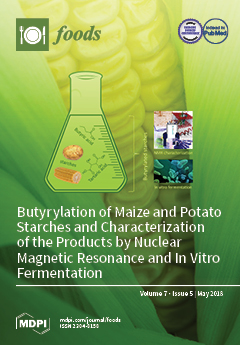The aim of this work was the qualitative and quantitative determination of selected phenolic compounds in three
Crataegus species grown in Bosnia.
Crataegus plants are consumed for medicinal purposes and as foodstuff in the form of canned fruit, jam, jelly, tea, and wine.
[...] Read more.
The aim of this work was the qualitative and quantitative determination of selected phenolic compounds in three
Crataegus species grown in Bosnia.
Crataegus plants are consumed for medicinal purposes and as foodstuff in the form of canned fruit, jam, jelly, tea, and wine. Two samples of plant material, dry leaves with flowers, and berries of three
Crataegus species—
Crataegus rhipidophylla Gand.,
Crataegus x subsphaericea Gand., and
Crataegus x macrocarpa Hegetschw.—were analyzed. Twelve ethanolic extracts were isolated from the selected plant material using Soxhlet and ultrasound extraction, respectively. Soxhlet extraction proved to be more effective than ultrasound extraction. A simple and sensitive method, high-performance liquid chromatography with electrochemical detection, HPLC-ED, was used for the simultaneous determination of phenolic acids and flavonoids in
Crataegus species. The content of gallic acid in the extracts ranged from 0.001 to 0.082 mg/g dry weight (DW), chlorogenic acid from 0.19 to 8.70 mg/g DW, and rutin from 0.03 to 13.49 mg/g DW. Two flavonoids, vitexin and hyperoside, commonly found in chemotaxonomic investigations of
Crataegus species, were not detected in the examined extracts. In general, leaves with flowers samples are richer in gallic acid and rutin, whereas the berries samples are richer in chlorogenic acid. Distinct similarities were found in the relative distribution of gallic acid among the three species. Extracts of
C. x macrocarpa had the highest content of all detected compounds, while significant differences were found in rutin content, depending on the plant organ. To the best of our knowledge, this is the first study reporting content of phenolic compounds in
Crataegus rhipidophylla Gand.,
Crataegus x subsphaericea, and
Crataegus x macrocarpa from Bosnia.
Full article






